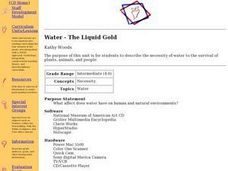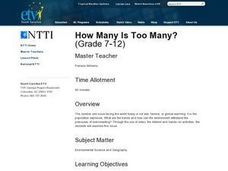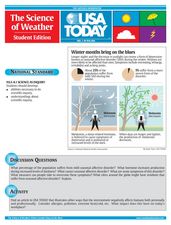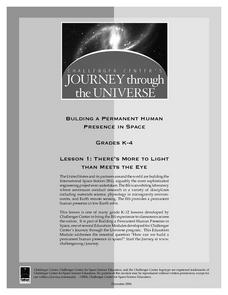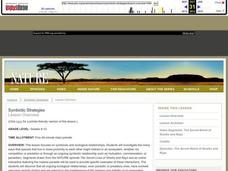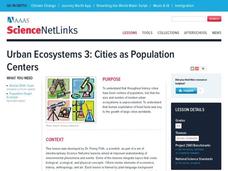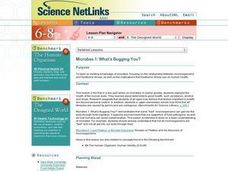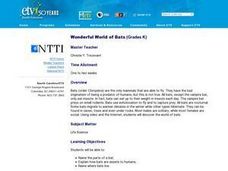Curated OER
EPA's Superfund Program
Students work together to gather information about the EPA's Superfund program. They discuss how to improve human health and the environment. They discover how hazardous wastes are characterized and cleaned up.
Curated OER
Biodiversity Study -- A Unit Study
Young scholars sample a site with low human impact, one with moderate human impact, and a third with high human impact. Students chart the data for each site and then compare the sites and discuss.
Curated OER
Water-The Liquid Gold
Students investigate the necessity of water for the survival of plants, animals, and people. They explore the affect that water has on human and natural environments through literature, field trips, and discussions.
Curated OER
How Many Is Too Many?
Students explore the population explosion. They view a video depicting the exponential growth of human population. Students research the internet to project future population data. They perform hands-on, multimedia activities to study...
Curated OER
Scientific Inquiry, Episode 1
Young scholars look at ways to help the environment. In this recycling lesson, students watch a video on pollution and then collect trash at their school. They create posters to share with the school about the importance of recycling.
Curated OER
I See a Coyote
Students role-play coyotes looking for natural resources. In this natural resources lesson, students examine the relationship between animal life and the environment. Students play a game that demonstrates how natural...
Curated OER
Ecology
Students make connections between their daily lives and the usage of natural resources as they relate to the importance of environmental quality. In this ecology lesson, students listen to the story The Lorax by Dr. Seuss...
Curated OER
Giraffe Riff Raff
Students study the effects of wildlife conservation and relocation. For this conservation lesson students view video on the preservation of the giraffe populations and discuss the impact that humans have had on them.
Curated OER
The Science of Weather
Students read an article. In this seasons lesson, students discuss the seasons and seasonal affective disorder. Students find an article that illustrates other ways that the environment negatively effects humans.
Curated OER
Water Cycle (Grades 2-4)
Young scholars demonstrate their understanding of the water cycle and how it effects the environment by graphically depicting and describing the water cycle.
Curated OER
Taking a Stand: Pros and Cons of Forest Fires
Students explain the components of fire, explain how forest fires impact man and the environment, analyze data in order to recognize areas that are at risk for forest fires, make recommendations based on research.
Curated OER
Construct And Test Roofs for Different Climates
Students investigate what types of roofs are appropriate for various types of climates and environments. They discuss and observe different types of roofs and housing, listen to the book "Houses and Homes," select a region, and design...
Curated OER
There's More to Light than Meets the Eye
Students explore the concept that not all light is visible to the
human eye. Although UV light is not visible, it can still be harmful, causing sunburns or skin cancer. They use special beads to detect UV light around the school....
Curated OER
Animal Skin
Students investigate the skin surface to body area ratios for different animals. In this seventh/eighth grade mathematics/science lesson, students explore heat transfer between an animal’s body and the environment. Using...
Curated OER
Turtle Lesson
Students explore the five common turtles that are native to the eastern United States. They investigate each turtle's characteristics, environment, means of protection, eating habits, and show how they can help these turtles survive.
Curated OER
Symbiotic Strategies
Students explore the different interspecies relationships namely mutualistic, commensal and parasitic. In this ecology lesson, students investigate an ecosystem disrupted by humans. They formulate an action plan to save it and present...
Curated OER
Urban Ecosystems 3: Cities as Population Centers
Students discover that throughout history cities have been centers of population but that human exploitation of fossil fuels was key to the growth of large cities worldwide. They research urban growth through a number of websites.
Curated OER
MICROBES 1: WHAT'S BUGGIN YOU?
Middle schoolers use existing knowledge of microbes, focusing on the relationship between microorganisms and foodborne illness, as well as the implications that foodborne illness has on human health.
Curated OER
The Gray Whale Obstacle Course Viewing Guide
Students complete a worksheet while watching a film about whales. They examine the human impact on whale migration and identify adaptations the whale has acquired in able to survive. They discover how global warming has effected the...
Curated OER
How To Find a Site
Fourth graders identify the three basic needs of humans. They identify on a map the best places to live and make a list of items that they can find on a map - streams, river, hills, plains, forests, etc.
Curated OER
Wonderful World of Bats
Students create a book about bats. They write a letter to a scientist containing questions about bats. They compare the socialization of bats to humans; compare the needs of bats to humans and other animals.
Curated OER
Building A Bug Bungalow
Students chart how milkweed bugs grow and change. In this growth and life stages activity, students read two stories and discuss how and why things grow. Students brainstorm what can be measured about humans, review and...
Curated OER
Dare to Care for a Grizzly Bear
Young scholars examine the relationship between humans and grizzly bears. In this biology lesson, students research about the bear's habits and living environment. They write a letter to the US Fish and Wildlife Service petitioning them...
Curated OER
Cancer Causes
Students explore why people get cancer. They explore human cells by taking a close examine their own. take a small sample of the epithelial cells that line the inside of their mouth. They glimpse how scientists investigate inside cells.
Other popular searches
- Human/environment Interaction
- Geography Human Environment
- Human Environment Interaction
- Human Environment in Peru
- Human Environment Relations
- Human Environment Vietnam
- Human Environment Africa
- Human Environment Asia
- Human Environment Community
- Human Environment School
- Human Environment Problems
- Human Environment Interaction


